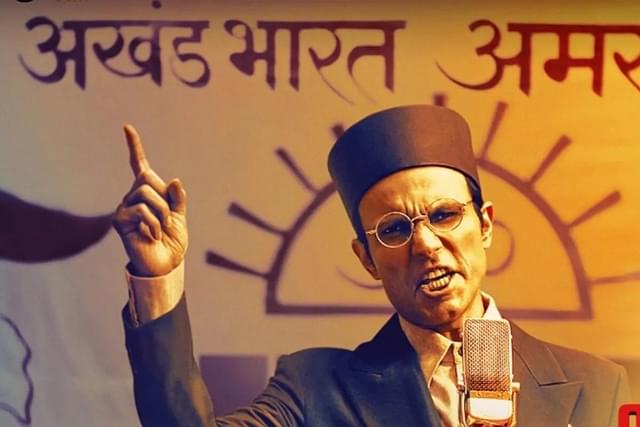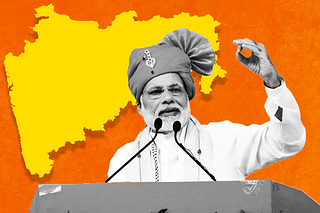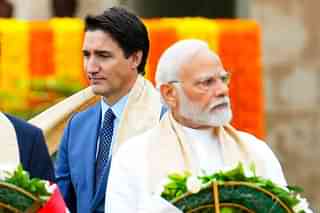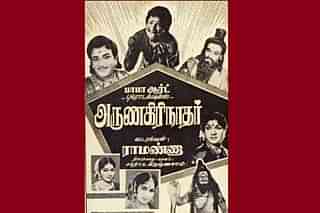Culture
Swatantrya Veer Savarkar: Please Take Your Kids To Watch This Movie
Aravindan Neelakandan
Mar 25, 2024, 04:28 PM | Updated Mar 26, 2024, 12:51 PM IST
Save & read from anywhere!
Bookmark stories for easy access on any device or the Swarajya app.

Swantantra Veer Savarkar is not a movie. It is nearly three hours of visual pilgrimage into the forgotten or rather hidden memories of India’s freedom struggle. The movie inspires, and is yet disturbing.
One is compelled to immerse oneself in the river of memory that was witnessed only by the prison cells of Andaman, the tortured inmates, and the even more tortured minds of our freedom fighters.
Swantantra Veer Savarkar is not a movie. It's a heartfelt homage from the present generation of Indians to the countless freedom fighters whose struggles and sacrifices have been overlooked in our textbooks and memories. This generation can be proud that they have done what the generation before failed to do.
Swantantra Veer Savarkar is not a movie. It is a visual prayer of repentance that actor-turned-director Randeep Hooda has made for all of us, for we have forgotten what should not have been forgotten.
The movie starts with the atrocities the British committed during the plague epidemics and the balidan of Chapekar Brothers, the latter inspiring a boy Vinayak Damodar Savarkar to take up arms against the British.
The movie shows the great vision that Savarkar had for liberating India through a network of revolutionary associations. It moves rather like any other biopic on a revolutionary. At one level, like all such biopics, it glorifies and even romanticises the revolutionaries. At another level, it also humanises the revolutionaries in flesh and blood.
For example, when Savarkar moves from Paris to London, the movie clearly shows that he was expecting a trial in London, and a three-year imprisonment, and more importantly, the voice of revolution getting a wider audience.
At this juncture, the film undergoes a remarkable transformation. The portrayal of Savarkar enduring solitary confinement, relentless beatings, harsh labour, calculated assaults on his sense of self-worth — all designed to break him mentally and emotionally — is depicted vividly yet without resorting to visuals of excessive violence.
It is hard to believe that this is the first movie directed by Hooda, who has also lived the life of Savarkar in the movie.
Even when depicting the most extreme tortures meant to shatter human dignity, the scenes illustrate how Savarkar maintains his dignity and fiery spirit of freedom without grand gestures or melodramatic words.
The movie has shown to the present generation, and bless Hooda for that, under what circumstances the so-called clemency petitions were written.
Savarkar, beaten and humiliated, stripped of his basic dignity, hungry, and physically broken, gazes at the partially-eaten and tempting food offered in a plate by Sir Reginald Haddock.
He is tempted. He physically needs that food. His body needs it. Haddock understands that. Offers the food. A split second. The spirit of the warrior is back in the beaten body of Savarkar, he refuses the food offered. The spirit triumphs over the body. This scene defines Savarkar. No melodrama. Not much of a conversation. A very few dignified gestures from both sides.
Perhaps, this will remain for long as one of the best scenes in a biopic.
The way the movie takes by its horns the vexed question of the so-called mercy petitions, is more than commendable. In the so-called "petitions," despite enduring torture, Savarkar had the strength to tell the British that they could keep him in Andamans if they wished, and release other political prisoners.
I've read the petition and was struck by Savarkar's strength. Seeing those words come to life in this film makes one realize the immense courage that burned inside Veer Savarkar's frail body.
One only prays that those who belittle the sacrifice of such purity, do not incur upon their own posterity the effects of that unforgivable sin.
Combined with the visuals of the sufferings Savarkar underwent in Andamans, the recital of the lines from the petitions acquires an effect that creates a catharsis in the hearts of viewers. No words of praise can do enough to what the director-actor has done to bring out the truth.
Hooda has transformed himself into the persona of Veer Savarkar. Or rather the soul of Savarkar seemed to have gripped him. Besides his physical efforts, such as reducing his body weight, the movie effectively portrays how the actor-director has deeply identified with the 'volcanic' personality of Savarkar.
The scene of only the brother of Savarkar waiting alone upon the former's release, with a surrealist sound track of scores welcoming Savarkar as they should have, seems to be a foreteller of ingratitude and devaluation of the sacrifice that would come to haunt this nation for long.
Definitely, this movie is a worthy tribute that has been long delayed and denied to the sacred memories of the ‘prince of revolutionaries’. It has also shown how in the aftermath of Mahatma Gandhi’s murder, Dr Narayan Savarkar was lynched by mobs of the apostle of non-violence.
Incidentally, Dr Narayan Savarkar was one of those rare individuals who stood for Dr B R Ambedkar in the court during Kalaram Temple Satyagraha.
Are there flaws in the movie?
Yes. Writing about the flaws in such a movie is not something the present reviewer likes to do. Yet, certain things need to be written and hence I write this after deleting the paragraphs below countless times.
First, there is not much evidence to conclusively say that Khudiram Bose was the inspiration of Savarkar. That came mainly from Aurobindo-Barinder circle and Anuhseelan Samiti. The movie has erred in the side of enthusiasm.Nevertheless, it took the this movie to take the sacrifice of Khudiram Bose to the nation.
Secondly, Dr Ambedkar did not take part in any discussion with Gandhi regarding the Khilafat movement. Those scenes could have been avoided.
Although more importantly, the movie has brought out the convergence in the views of Veer Savarkar and Dr Ambedkar.
Third, the characters of V V S Iyer should have been given a much better treatment.
Fourthly, the depiction of the relationship between Veer Savarkar and Gandhi could have been better. The scene where Gandhi sends his card and Savarkar returns it, citing Gandhi’s assistance to the British in the Zulu rebellion, seems more like a contrived scene than a historically accurate one.
Fortunately, V V S Iyer had given a better description of the London encounters of Gandhi and Savarkar. The fact of the matter was Gandhi was the only leader who was ready to preside over the Vijayadashami event conducted by India House after Curzon Wyllie was assassinated.
Even leaders of the extreme faction of Congress kept themselves away from India House after the assassination. It was Savarkar who suggested that Gandhi be invited to preside over the function. Gandhi insisted that the food should be cooked by the students and should be vegetarian.
Savarkar agreed to both the demands. While Savarkar definitely carried the day with his oratorial skills, Savarkar’s closest friends in the house, V V S Iyer and Rajan, got transformed by the speech of Gandhi.
It was the discussions that Gandhi and Savarkar had over two days prior to the function that became Gandhiji’s Hind Swaraj.
The portrayal of the central figure's antagonists is always crucial in a biopic. In this case, both Jawaharlal Nehru and Gandhi were depicted in a caricatured manner, which was unnecessary.
For example, when Nehru was arrested by the British, Savarkar strongly condemned it. This could have been shown in the movie, along with Nehru grooming roses in the jail, to contrast the luxurious incarceration of Nehru with the treatment given to Savarkar.
Such a scene would have shown that the very term ‘prison life’ had an entirely different meaning for Nehru and Savarkar.
Yet in the context of 2024, the current Congress leadership's deep-seated animosity and vitriol towards Savarkar almost justifies the caricatures of Gandhi and Nehru.
The film has done justice to the life of a great man, who had seen mainly suffering and misunderstanding in his own life.
Swatantra Veer Savarkar is a must-watch for every Indian, particularly the Indians of the younger generation. They will know that the freedom they have is the result of the sacrifices of extreme kind by not only the freedom fighters, but also their families.
I will request every Indian parent to take their children to watch the movie. That is the least we can do to honour one of the greatest of freedom fighters of not just this nation but of humanity.
Save & read from anywhere!
Bookmark stories for easy access on any device or the Swarajya app.
Introducing ElectionsHQ + 50 Ground Reports Project
The 2024 elections might seem easy to guess, but there are some important questions that shouldn't be missed.
Do freebies still sway voters? Do people prioritise infrastructure when voting? How will Punjab vote?
The answers to these questions provide great insights into where we, as a country, are headed in the years to come.
Swarajya is starting a project with an aim to do 50 solid ground stories and a smart commentary service on WhatsApp, a one-of-a-kind. We'd love your support during this election season.
Click below to contribute.





